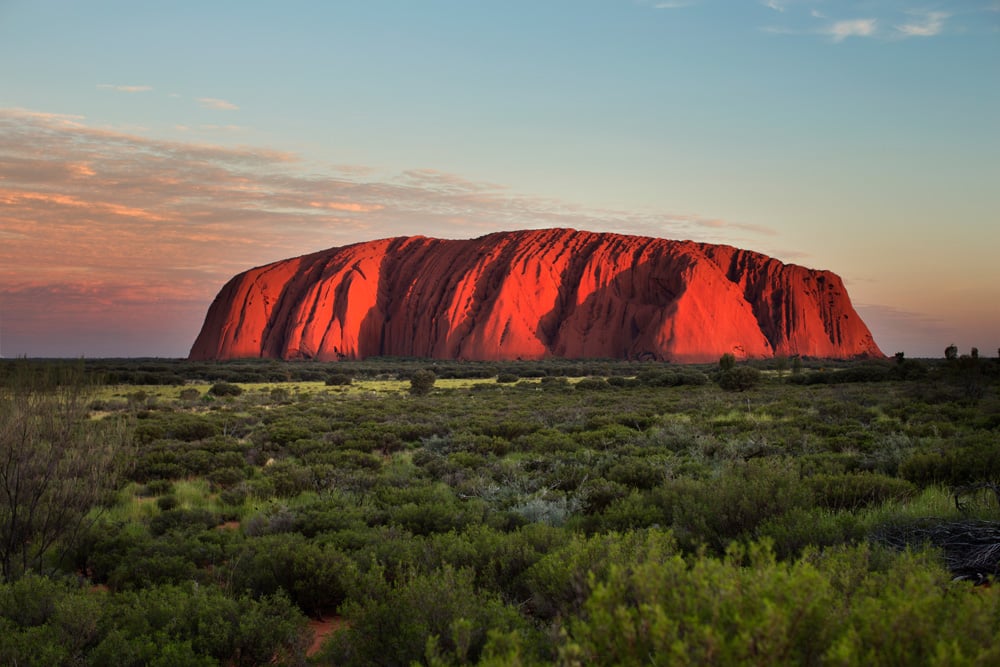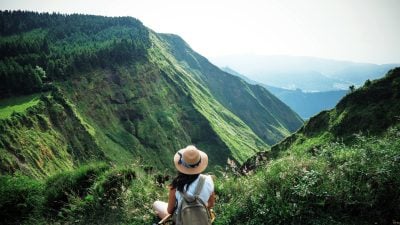Home / Australia & South Pacific / Uluru Invites You to See Red

Uluru Invites You to See Red
If you’ve only seen Uluru in pictures, or on a long-ago trip, it’s time to put the world’s most iconic rock on your itinerary. More than just one of best things to see in Australia, Uluru is the heart of this ancient land, held sacred by Australia’s Aboriginal people, including the Anangu, who still care for the site today. To the world’s oldest living culture, Uluru is a crossroads between ivara, the sacred paths that carry the memories of demigods across Australia.
After dark, those memories come to life in a vivid fusion of light, colour, and storytelling.
In a laser and light show delivered by over 1,100 drones, Wintjiri Wiru (Pitjantjatjara for “beautiful view out to the horizon”) tells the ancient story of the Mala people, the devil-dog Kurpany, and the kingfisher woman Luunpa, whose warnings the Mala refused to heed. It’s a seamless fusion of past and future, as the desert’s glowing sunset fades and this Anangu tale passed down through generations comes to life over the timeless rock.

Uluru, the nearby domes of Kata Tjuta, and the surrounding desert have long been known for their spectacular colours, particularly at sunrise or sunset, when the rock glows pink and orange in the changing light. More recently, the desert has come to life after dark in Tili Wiru Tjuta Nyakutjaku (“looking at lots of beautiful lights”) or Field of Light, a spectacular installation of 50,000 lights by artist Bruce Munro.
Of course, Uluru came to life long before visitors began flocking to see it. The ancient rock is a nonstop hub of natural and spiritual activity, from Australia’s most beloved native animals, to the spirits of Anangu ancestors, and even unexplained weather phenomena. Why in the height of the dry season do the rains fall on Uluru and Uluru alone, and how do the Anangu manage to predict such rains with such accuracy?
These are questions best answered on a guided walk around the base of Uluru, or through the gorges of Kata Tjuta. This is by far the best way to discover the stories and sacred places that define the region in Aboriginal culture (and define that culture in turn). You might hear different versions of the same tales, as various nations and tribes have their own version of Uluru’s story. But all agree on the sacred significance of this unique place. The Uluru climb was permanently closed in 2019, allowing traditional beliefs to be respected while keeping visitors safe and allowing them to enjoy a much more satisfying look at Uluru.
Perhaps the ultimate view takes in an Uluru sunset before a Sounds of Silence dinner (best enjoyed with a glass of bubbly in hand). A digeridoo performance and a guided tour of the southern night sky accompany the three-course bush tucker inspired buffet, inviting you to taste the region’s heritage while taking in the beauty of Uluru and Kata Tjuta. From sunrise to sunset and beyond, there’s never been a better way to see red.
This article was originally published in No. 31 of Globetrotting Magazine.
Get more travel inspiration by email.
Subscribe
0 Comments

Get the latest travel trends & hear about the best deals on vacations around the world.
If you’re a Globetrotter, these are the newsletters for you!



